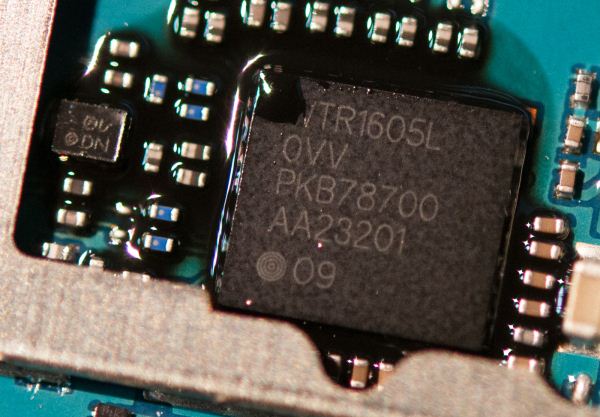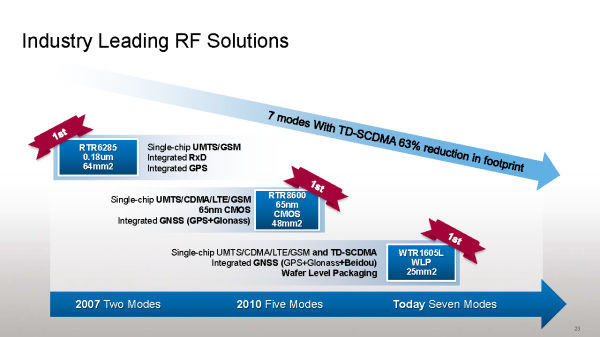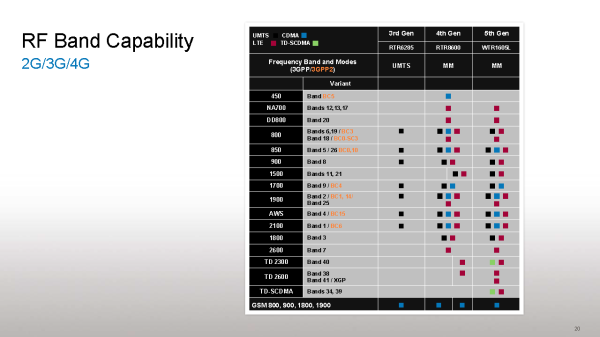The State of Qualcomm's Modems - WTR1605 and MDM9x25
by Brian Klug on January 4, 2013 9:48 PM ESTQualcomm's New Flagship Transceiver - WTR1605
The big new news information disclosure from Qualcomm relates to the capabilities and specifications of their new flagship transceiver, WTR1605 and how it compares to the previous generation, RTR8600. There are a number of new additions, but at a high level it boils down to different packaging (wafer level instead of plastic), inclusion of support for more primary receive bands (7 instead of 5), and support for one more GNSS constellation (the addition of the Chinese system, Beidou) over the previous generation. WTR1605 comes in two flavors, with WTR1605L including L for LTE. The first character in the name indicates package type, which is now wafer-level (hence the W) instead of a plastic, which Qualcomm tells me it can now inspect and test just as effectively as the plastic packaged previous generations. This allows the overall size of WTR1605L to be smaller in spite of it still being fabricated on a 65nm RF CMOS process (there was some previous documentation which suggested that WTR1605L was 28nm RF CMOS, this is not the case).
As a deviation, I also enquired whether we’ll see transceiver ever make it back inside the baseband package, similar to how MDM6x00 was a combination of baseband and transceiver in one single package. Other baseband manufacturers also have sold combination baseband and transceiver parts before, for example LG’s L2000 LTE chipset is a combo part. I originally suspected that this move back to discrete was done to decouple the two roadmaps (since we’ve seen MDM9x15 originally ship with RTR8600 and only now have seen phones with WTR1605L inside), but it turns out the reason is both the multiplicative effect of yields when combining multiple devices into one package (essentially cost), and that the overall system size is smaller with discrete wafer level packages for transceiver.
| RF Ports Comparison | |||||||
|
RTR6285 (3rd Gen) |
RTR8600 (4th Gen) |
WTR1605(L) (5th Gen) |
|||||
| Package Size, Type, Geometry |
64 mm^2, Plastic 0.18µm RF CMOS |
48 mm^2, Plastic 65nm RF CMOS |
25 mm^2, Wafer-Level 65nm RF CMOS |
||||
| Air Interfaces | UMTS/GSM | UMTS/GSM/CDMA/LTE | UMTS/GSM/CDMA/LTE-A/TD-SDCDMA | ||||
| GNSS Support | GPS | GPS, GLONASS | GPS, GLONASS, Beidou | ||||
| Primary Rx | HB (2.1 - 2.6 GHz) | 0 | 1 | 1 | |||
| MB (1.5 - 2.1 GHz) | 2 | 2 | 3 | ||||
| LB (700 - 900 MHz) | 2 | 2 | 3 | ||||
| Diversity Rx / MIMO | HB (2.1 - 2.6 GHz) | 0 | 1 | 1 | |||
| MB (1.5 - 2.1 GHz) | 2 | 2 | 1 | ||||
| LB (700 - 900 MHz) | 1 | 2 | 2 | ||||
| Transmit | HB (2.3 - 2.6 GHz) | 0 | 1 | 1 | |||
| MB (1.5 - 2.1 GHz) | 3 | 4 | 4 | ||||
| LB (700 - 900 MHz) | 2 | 4 | 4 | ||||
| Total Rx Ports | 7 | 10 | 11 | ||||
| Total Tx Ports | 5 | 9 | 9 | ||||
The biggest change with WTR1605 is the inclusion of two more primary receive (Rx) ports over the previous generation, RTR8600. Qualcomm uses a low band, mid band, and high band convention for its ports, which is a common industry practice. These ports are tuned to work over the given band of frequencies, and are all created equal in terms of capabilities, and all wide enough to all do 20 MHz LTE or more. The addition of one more low band and mid band primary receive port on WTR1605 enables a number of configurations for handsets that weren’t possible previously without including a switch outside and incurring some loss. Probably the best example is delivering a device with both Band 17/12 and Band 13, 700 MHz North American coexisting on the same handset (Band 13 is Verizon LTE in the USA, Band 17 is AT&T LTE), and for the extra mid band port, Band 3 (1800 MHz) LTE. More ports means more bands without using up a lot more area on the PCB, and the number of LTE bands is continuing to increase.
I was a bit intrigued by the loss of a mid band diversity port from RTR8600 to WTR1605 and what implications this would have on LTE operation where receive diversity is mandatory for all UE categories, and because this “diversity” port is really the second receive chain mandatory for UE categories 2 and higher. The answer is that the mid band diversity port can accommodate 6 dB of difference from the primary port and the receiver can still do its diversity combining (MRC or so on) and get appreciable gains out. Thus adding a switch in front (around 0.2–0.5 dB of loss) doesn’t incur so much as to be a real problem — and the tradeoff yields one more mid band primary port.
The final addition is TD-SCDMA compatibility which is very important for the Chinese market, specifically China Mobile. Previous to this disclosure, I was unaware that only WTR1605 in conjunction with appropriate baseband is capable of working with TD-SCDMA. This second chart lists all the currently disclosed bands that all three generations are specified as supported, and indicates that only the latest generation includes TD-SCDMA support. The fact that WTR1605 is necessary for TD-SCDMA has implications for a number of handset designs which shipped with MDM9x15 and included RTR8600 for time to market reasons but by an OEM with clear designs on shipping TD-SCDMA enabled SKUs.
I expect that WTR1605 will stick around and be paired with MDM9x25 in the future in addition to MDM9x15 where we’ve seen it first emerge. Clearly Qualcomm feels its synthesizers onboard WTR1605 are up to the task for the number of inter-band and intra-band carrier aggregation combinations being posed in 3GPP Release 10.
Overall WTR1605 is a step in the right direction with more primary receive ports over the previous generation. More ports means a step closer toward the holy grail of a single SKU with all the necessary LTE bands for multiple regions. Unfortunately even with 7 total ports for bands, LTE roaming and shipping a single SKU still remains a difficult to impossible prospect for even the most aggressive OEMs. Obviously the long term goal is to be able to accommodate more ports, the challenge is doing so without driving up cost or size dramatically.



















20 Comments
View All Comments
wavetrex - Friday, January 4, 2013 - link
Well, my mother didn't make me smart enough so I understand all this electronics stuff... but what I get from the article is that new technology will enable future phones to download porn faster. Yay !iwod - Sunday, January 6, 2013 - link
That is true, I think for most Anantech reader where we could understand a High Level details of Node, Fabs, ISA, x86 / ARM, Decoder, Pipeline, GPU Compute etc, Wireless Spectrum, transceiver, Modem and Baseband are something we have hard of but know not much about it. I admit i had to look up a lot of things just to get along with this article when a lot of these wont previously explained in Anand's article at all.Would be great if Anand could do a Basic explanation 101.
ImSpartacus - Tuesday, January 15, 2013 - link
That's what I love about Anandtech. Anand does spectacular explanatory articles and the other writers aren't too shabby.Belegost - Saturday, January 5, 2013 - link
So, first, that initial slide showing the Modem SS block and mod/demod with links to VPE and QDSP6 is painful. Even at a high level that is so inaccurate it hurts.Second, 4 layer MIMO in r9 is lip service. The necessary spec information to support a 4 Rx configuration is missing, r9 effectively caps out at 4x2 2layers, which is being actively deployed in Korea right now.
Finally, the Cat3 limitation is not on the usable number of Resource Blocks (RBs) but on the number of information bits (uncoded bits) that can be transmitted in a single transmission instance (subframe) and the number of soft bits that are stored in the coded buffer for rate matching. 9615 and 8960 devices can use all 100RBs available in 20MHz, provided the amount of information to be sent is kept within the limit on information bits. This prevents the highest coderates from being used with that many RBs, but there is no limitation on how many (or few) RBs that can be allocated.
Wwhat - Sunday, January 6, 2013 - link
That powerpoint presentation is generally full of twisted non-information and about the same level of detail and accuracy as a wrinkle cream ad.But that's exactly what it is, an ad.
Brian Klug - Monday, January 14, 2013 - link
Obviously parts of that are just marketing, but this is a first step to getting them to disclose a much more comprehensive high level block diagram. Also I'd love to know how you'd draw the diagram as well.-Brian
Kogies - Saturday, January 5, 2013 - link
Stepping away from the more sexy discussion points of a smart-phone is always going to be tough, yet you have done so. With LTE, as you mention, being far from a simple "is this phone LTE capable," specifications such as ports/bands are in greater need of proliferation.I have a question, if the carriers are refarming the existing bands for LTE, what is stopping a device which is LTE capable using that band, if it is available in the 2G/3G spectrum? One doesn't require different filters for different modulations, do they?
Now if only I could crack open one of these base stations...
watersb - Saturday, January 5, 2013 - link
I've enjoyed listening to the podcasts and hope to have this article assimilated before the CES deluge. (Humor me. January and I'm feeling aspirational...)Brilliant stuff.
jaysns - Saturday, January 5, 2013 - link
Many months ago in a conference in Atlanta where the CTO was present I remember hearing about if how the Metro merger goes through and once their spectrum is consolidated with ours that in areas where the have 40 Hz available we will be deploying 148 Mpbs; though I do not expect handsets that can support those speeds to be available as we light up the first few cities. How quickly the merger goes through will determine that as much as our ability to deploy it though.Drazick - Saturday, January 5, 2013 - link
Will You, Please, Update Your Google+ Page?It would be much easier to follow you.